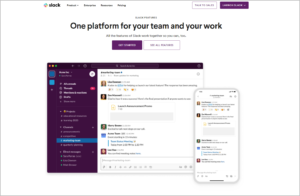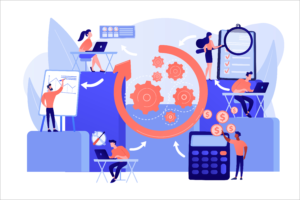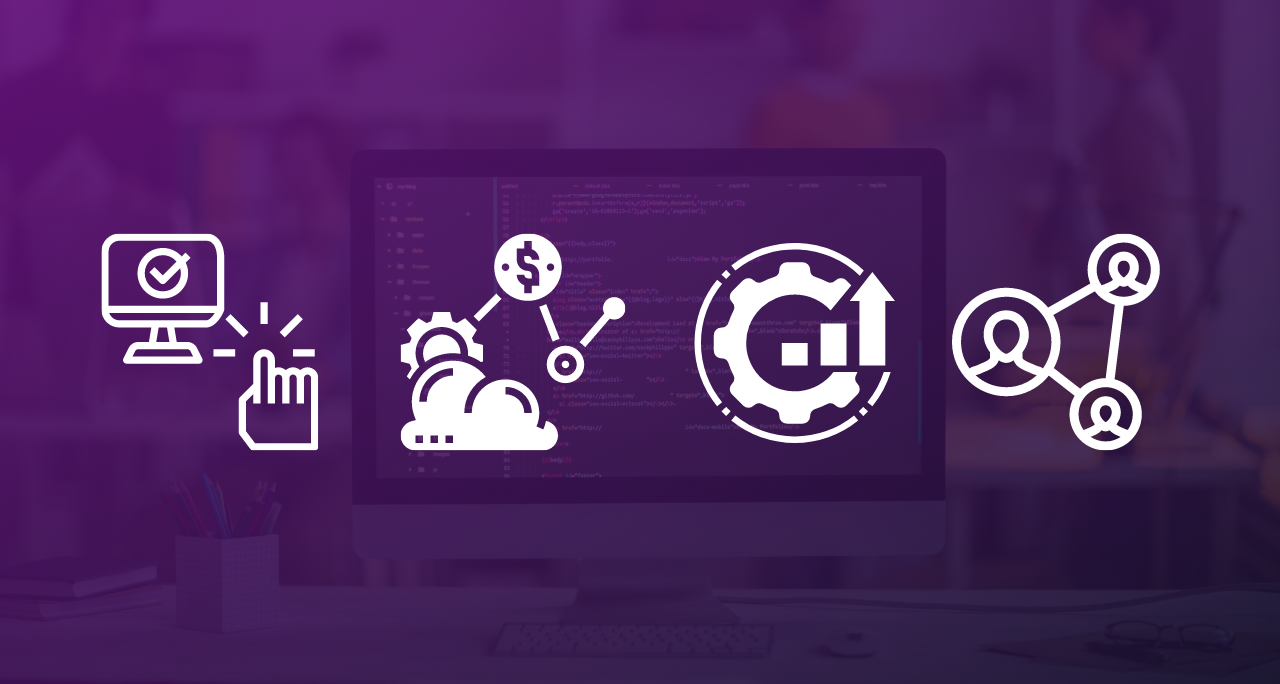Product-led growth (PLG) strategy is a method companies can use to effectively leverage their products in such a way that can convert active users to paying customers, retain them and get new ones through referrals. But at the same time, effectively applying a PLG strategy requires more than just following a simple formula.
Key to understanding how PLG works is recognizing that conveying the value of your product to users is paramount.
We’ll take a detailed look at what product-led growth is, how product-led growth emerged from existing business trends, and how changing consumer expectations are driving it forward. Then, finally, we’ll look at how you can take advantage of this new paradigm within your own business.
What is Product-Led Growth?
The idea of product-led growth has a strange history. It has recently been codified and promoted by one firm in particular (OpenView Venture Partners) but, in reality, the core tenets of the idea have been around for decades.
The basic principle of product-led growth is this: that if a product provides real value for consumers, they will start to weave it into the way they work and live on a regular basis. As they do so, their peers, colleagues, and friends will come under pressure to adopt the same product: either because they want systems and tools that are compatible with their colleagues, or because their friend told them a particular product is great.

Looked at from this level of abstraction, it can seem that product-led growth applies to almost any successful product, but it doesn’t. The crucial difference of product-led growth strategies, in contrast to their more “traditional” counterparts, is that these strategies aim to provide real value to customers in a way that inherently encourages them to recommend a product. Instead of relying on customers to evangelize a particular product, you make sharing it part of the appeal.
There are many examples of this in recent years. Arguably the most successful has been major cloud-based office software suites such as Sync or Google Drive, which put their collaborative features at the foreground in order to encourage users to invite their colleagues onto the platform. In other words, anywhere information needs to be shared between customers, there is an opportunity to use product-led growth.
The Quintessential Example: Slack
The way in which product-led growth (PLG) works is best understood using an example. Take a look at the guides to implementing PLG, and you’ll quickly see that there is one example that is used far more often than any other: Slack.
PLG in Slack works like this: two employees will start to use Slack to work on a one-off project. Because it provides a lot of value to these two employees, they will either recommend it to their colleagues, or even actively add them to their Slack workspaces. Then, other teams at the same workplace will start to use the system – teams who will have different needs from the original team, and may well make a purchase from Slack.

Source: Slack
You’ll notice two key elements that are crucial to this example. One is that Slack is very easy to sign up to and start using, and this allows usage of the system to spread like wildfire throughout an organization (or even a group of friends). The second key element is that Slack provides genuine value to those people who use it – it makes the otherwise complex and annoying process of collaboration much easier.
It is in this last regard that we can see the difference between a piece of software like Slack, and something like Microsoft Office. In the case of the latter, it is generally managers and IT consultants who make the decisions to use a suite like Microsoft Office – adoption of Slack is often driven “from below”, by employees themselves.
As a result, the process of customer relationship management for both companies is completely different. Slack focuses on providing value to individual users, and trusts them to bring others onboard. Microsoft spends more time courting high-powered execs who might be interested in buying a license.
The New Era
So far, so good, but you still might have some doubts about whether the PLG model is right for your business. That’s legitimate, and as with any new paradigm you will have to look carefully into whether this model suits your business. In truth, and despite recent claims to the contrary, PLG is a strategy that can work extremely well for software companies, but is of limited utility outside of this sector.
PLG is, in fact, a natural development for the software industry, which has evolved through at least three distinct eras when it comes to sales. Back in the 1980s, when software cost hundreds of thousands of dollars per license, software companies employed sales reps to convince data scientists to spend big.
As the new millennium dawned, a new paradigm started to inform software sales. As technology became commonplace in the workplace, and then a necessity in it, executives started to look at the money they were investing in software in terms of ROI. In response, software companies started to stress that their software was continuously evolving in order to meet the needs of staff, and have moved much of their services and infrastructure over to the cloud.

Now, we are entering a new era, which might be called the “end user era”. Today, the idea of infrastructure, storage, or computing limitations are still challenging for some users and companies, but the way in which software licenses are designed means that all three of these resources can instantly scale in line with what the end user wants.
As a result, the “middle man” is increasingly disappearing from the whole business of software sales. With strategic evolving based on outcomes and enablement, software companies are courting end users, rather than their bosses. Because using a new system no longer requires that a company invest in a new data center, many organizations are happy to permit their employees this kind of freedom, as long as it improves their productivity.
This shift mirrors those in the larger economy. We are slowly moving away from a world in which employee value is measured in terms of hours worked, or even years of experience in a particular field. Instead, expert knowledge and agility are now prized skills.
The Drivers of Product-Led Growth
So much for ancient history: what is driving the success of PLG, and why should you adopt this strategy? Well, there are three key reasons why PLG can deliver value:
1. Customers Prefer It
Believe it or not, many of your customers won’t be ready from the start to interact with a Sales Rep. Instead, and according to research by Forrester, 75% of B2B purchasers want to educate themselves instead of talking to sales representatives about products.
Can you imagine applying the old model of software acquisition to something like Netflix? A potential customer would first download a whitepaper on why Netflix was a ground-breaking service. Then they would get a call from a sales rep, who would make an appointment to deliver a sales presentation. Sounds absurd? It is. And yet this is the way in which a lot of software is still sold.
Product-led growth companies predominantly rely on self-service approaches. But even so, assisted sales should not be neglected, and it’s something that many PLG companies may need for clients at some stages, like upgrading.
2. Your Customers Will Thank You
The counterpoint to the above is that, if you can offer genuine value to your customers, in today’s economy they will become your most effective marketers. This is because they will tell everyone about your products on social media.
This is precisely why word of mouth and referral marketing have become such a big business recently, and why the best social listening platforms like Hootsuite, Mention or BuzzSumo now allow you to track social media mentions as well as more traditional media.

The main point to remember here is that it’s always easier to acquire new customers when they have learned about your company or your product via word-of-mouth. You can set up referral systems in a very down-to-earth and subtle manner; for example, you can make your product easily shareable so it’s more likely to spread among users.
3. It Works
Not to put it too bluntly, but PLG is now a proven strategy with a proven ability to generate profits. Customer acquisition costs are on the rise in many sectors, with one study from Profitwell finding that SaaS CAC (customer acquisition cost) has increased by over 55% in the last five years, while willingness to pay has decreased by 30%.
PLG is a powerful solution to this problem. Openview recently conducted their own study comparing companies who used product-led growth to those who did not. The results showed outperformance by product-led growth companies in almost every area.

Transforming Your Company
If the above has convinced you that the PLG model is achievable and if this approach fits your product offering, great. Exploring the possibilities of this paradigm need not be expensive, and you can even pursue it alongside your traditional growth models. There are a few key elements to getting into PLG, though.
Let’s break them down:
- You might have had a long internal debate about how to price products. If you want to use the PLG model, though, you need to absolutely offer free trials. And because you have a limited timeframe when the user will experiment with your product, you need to make sure your product is optimized and fully functional so that new customers will achieve their desired outcomes within a short period of time.
- Similarly, you should offer very low barriers to entry for your products, and focus on providing a self-service model rather than a sales-assisted demo.
- An increased focus on new customer outreach will also be required, in order to build up a critical mass of users who can then recommend more. Seek out early-adopter users by showcasing your new product on niche channels, reaching them by email, forums and communities, and even social media.
- Besides new acquisition, what is the biggest lever of growth, or put the other way, the biggest growth challenge? Look within your product to find that out. This is a very important aspect as growth happens mostly organically in product-led companies.
- Think very carefully about how your product fits into the tech stack, and the everyday workflow of your customers. If this means providing integrations between your product and “the competition“, so be it – the value of your product is the most important driver of growth.
- Finally, think again about what you regard as the most important KPIs for your business. In PLG models, real-world usage of your product and tracking acquisition, onboarding metrics and retention rates may be more important KPIs than tracking your gross revenue.
If you are still stuck for ideas, take a look at the competition, and examples of companies which have successfully leveraged the PLG model. These include Dropbox, GitHub, and Trello – three of the biggest names in productivity software today.
Conclusion
Ultimately, PLG returns your focus to the place where it should be – building a product that is genuinely useful for your customers, and which they will find invaluable in their everyday lives. The fact that the model is also a highly profitable one is a nice coincidence.
________________________________
About the Author:

Nahla Davies is a software developer and tech writer. Before devoting her work full time to technical writing, she managed—among other intriguing things—to serve as a lead programmer at an Inc. 5,000 experiential branding organization whose clients include Samsung, Time Warner, Netflix, and Sony.





